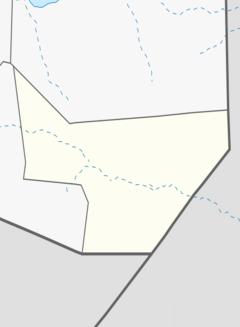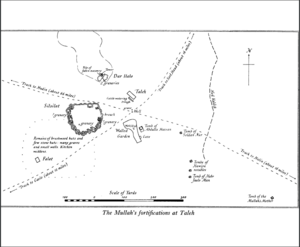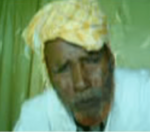Taleh facts for kids
Quick facts for kids
Taleh
Taleex
تليح
|
|
|---|---|
|
Town
|
|

The Dervish fort / Dhulbahante Garesa in Taleh
|
|
| Country | |
| Regional State | |
| Region | Sool |
| District | Taleh District |
| Population
(2007)
|
|
| • Total | 4,374 |
| Time zone | UTC+3 (EAT) |
Taleh (Somali: Taleex, Arabic: تليح) is a historic town in the Sool region of Somalia. It was once the main city for the Dervish movement before Somalia became independent.
The Dervish movement built many structures in the area. The Dalyare fort and the Taleh complex were built between 1909 and 1910. These are some of the best-preserved Dervish buildings in the Sool province. Taleh took over from Eyl (Illig) as the Dervish capital in 1905 and remained so for four years.
Contents
History
The Dervish State
The Dervish State was a Somali Muslim movement led by Mohammed Abdullah Hassan. They fought against colonial powers in the early 20th century.
Why Taleh Became the Capital
Taleh was chosen as the Dervish capital for a few reasons. It is located in the heart of the Dhulbahante territory, a group that supported the Dervish. Its location in the Nugaal Valley also made it far from areas controlled by colonial governments. This distance helped protect the Dervish from their enemies.
Dervish Forts
Taleh is famous for its old buildings from the Dervish era. Five main forts were built by the Dervish movement between 1901 and 1915. Most of these forts are in the Sanaag and Sool regions. These include Dalyare fort, Jidali fort, Midhisho, Shimbir Bariis, and Badhan. Taleh has the largest of these structures.
A Dervish veteran named Cabdi-Yaar Cali Guuleed said that the Taleh fort was the biggest. He mentioned it was built between 1909 and 1910. He described it as the Dervish headquarters, located in the northern part of the Nugaal Valley.
The main fort was built around Dervish tombs. One of the earliest tombs belongs to Sultan Nur Ahmed Aman. Another is for Carro Seed Magan, the mother of the Dervish leader, Diiriye Guure.
The Fall of Taleh
In 1920, the British Royal Air Force (RAF) attacked the Dervish forts. They used airplanes to bomb the structures. This forced Mohammed Abdullah Hassan's men to retreat to Taleh. The British then attacked Taleh on February 4, 1920, with help from local horsemen. They defeated the last Dervish fighters.
Some important Dervish leaders were lost during this battle. These included commander Ismail mire and Artan Boos. They were close to the Dervish leader. Muhammad Abdullah Hassan himself managed to escape. He fled to the Ogaden region, but his forces were later defeated there in 1921.
After the Somali Civil War
After the Somali civil war began, the Sool region faced a severe drought. Many local nomads lost their animals and moved to cities like Las Anod.
In January 2012, the Dhulbahante clan declared the independence of Khatumo State. They named Taleh as its capital. However, other countries and neighboring states like Somaliland and Puntland did not recognize this.
There have been conflicts in Taleh between forces from Puntland and Khatumo. In April 2014, Somaliland sent troops to occupy Taleh. They withdrew one day later. Somaliland also briefly occupied Taleh again in June 2014.
In April 2019, Somaliland forces took control of the Taleh district. The Khatumo forces left without a fight.
Taleh has faced challenges like water shortages. In April 2019, a lack of water caused health issues like diarrhea. The town does not have a hospital. People often travel to nearby cities like Las Anod or Garoowe for medical care.
Silsilad
The term "Taleh" or "Taleex" often refers to the entire Dervish fort complex in the town. However, it actually applies to only one of the buildings within a four-part compound. This complex includes Falat, Silsilad, Dar Ilaalo, and Taleh (the specific fort).
The main fortress, Silsilad, is about 350 feet long and 300 feet wide. Dar Ilaalo is a look-out tower, about 50 feet high, built on a small hill behind Silsilad. The Taleh fort itself is also about 50 feet high and is located on lower ground to the east.
Horse Stable
Besides housing people, Silsilad also had a stable for horses. The Dervish had different types of horses, like Barroor (beige) and Xamar (chestnut). They would choose which horse to use based on how hot the sun was.
Demographics
The town of Taleh has a total population of 4,374 people.
Climate
| Climate data for Taleh | |||||||||||||
|---|---|---|---|---|---|---|---|---|---|---|---|---|---|
| Month | Jan | Feb | Mar | Apr | May | Jun | Jul | Aug | Sep | Oct | Nov | Dec | Year |
| Mean daily maximum °C (°F) | 29.5 (85.1) |
30.3 (86.5) |
31.9 (89.4) |
33.2 (91.8) |
34.0 (93.2) |
32.9 (91.2) |
31.9 (89.4) |
32.6 (90.7) |
34.0 (93.2) |
32.7 (90.9) |
31.1 (88.0) |
29.7 (85.5) |
32.0 (89.6) |
| Mean daily minimum °C (°F) | 14.0 (57.2) |
15.1 (59.2) |
16.2 (61.2) |
19.1 (66.4) |
20.8 (69.4) |
21.4 (70.5) |
21.4 (70.5) |
21.1 (70.0) |
21.0 (69.8) |
18.6 (65.5) |
15.6 (60.1) |
14.9 (58.8) |
18.3 (64.9) |
| Average precipitation mm (inches) | 1 (0.0) |
1 (0.0) |
3 (0.1) |
19 (0.7) |
39 (1.5) |
3 (0.1) |
1 (0.0) |
1 (0.0) |
10 (0.4) |
24 (0.9) |
7 (0.3) |
2 (0.1) |
111 (4.1) |
| Source: Climate-Data.org | |||||||||||||
Education
Taleh has several schools. The Somaliland Ministry of Education says there are eight primary schools in the Taleh District. Some of these schools are Kalad, Labas, Aroley, and Halin.
Notable People
- Sheikh Bashir - A Somali religious leader, born in Taleh in 1905.
- Nur Ahmed Aman - One of the leaders of the Somali Dervish movement, who died in Taleh in 1907.
- Haji Sudi - Another leader of the Somali Dervish movement, who died in Taleh in 1920.
- Ibrahim Boghol - A member of the Dervish council, who died in Taleh in 1920.
- Abdisamad Ali Shire - A former Vice President of Puntland, born in Taleh.
- Abdikhadir Ahmed Aw-Ali - The current president of SSC-Khatumo State of Somalia, born in Taleh in 1972.






